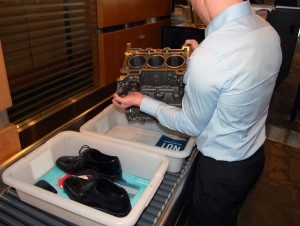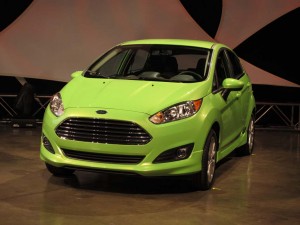For the second year in a row, Ford Motor Co.’s 1.0-liter EcoBoost engine has been named International Engine of the Year.
The high-mileage powertrain has been available in Europe for several years and is just being launched in the U.S., as well as China and India, later this year. The newest member of the EcoBoost family was picked as “Best Engine Under 1.0-liter,” according to Engine Technology International Engine.
“Who’d have believed it? A 1.0-litre engine that has it all, powerful, fuel efficient, clean and lightweight,” said Peter Lyon, a British juror and freelance journalist. “This is a masterpiece.”

The block for the new 1.0-liter EcoBoost engine is small enough to fit in a carry-on bag -- and is shown here going through airport security.
Ford has invested heavily in its EcoBoost line-up, a family of engines ranging from the big V-6 now offered as one of the most popular choices in the maker’s big F-Series pick-ups to the 1.0-liter 3-cylinder powertrain.
The 1.0-liter EcoBoost is already available in Europe and found in a wide range of vehicles including the Fiesta, Focus and C-Max. It will soon be added as an option on the Transit Connect and Tourneo Connect vans and Mondeo sedan.
Until recently, it was thought engines of this size were too small for the U.S. market but Ford is bringing out a version of the Fiesta with the 1.0-liter EcoBoost later this year, with the engine also going into the EcoSport crossover for India and China.
(First Drive: Ford Fiesta with 1.0-liter EcoBoost. Click Herefor the review.)
Like other EcoBoost engines, the 1.0-liter package uses a turbocharged direct injection system that borrows many of the technical tricks that have helped boost both the performance and fuel economy of modern diesels. But it uses standard unleaded gasoline.
“With a technology as mature as the internal combustion engine, it’s very rare to achieve a true breakthrough, but that is exactly what the team accomplished with this engine,” said Joe Bakaj, Ford vice president, Global Powertrain. “You have to drive it to believe a small three-cylinder engine can deliver such performance and fuel economy.”
Ford offers a number of EcoBoost variants in the U.S., including the V-6 in the F-Series pickups, and a 1.6-liter inline-four in various mid-range models. It will soon add a new 1.5-liter four-cylinder variant.
(For more on that 1.5-liter EcoBoost, Click Here.)


The Eco-Boost engine series looks pretty good so far other than some minor issues. A 1.0 L engine for the U.S. is a tough sell. It might appeal to a small market segment but the lack of start-off torque is a real issue for U.S. drivers. Euro drivers are use to lack of low end torque with small engines so tiny engines don’t bother them unlike in the U.S. where folks are use to lots of low end grunt.
Once in boost the torque is fine on these smaller engines but start-off can be an issue even with real high numerical transmission first gear ratios that are typically used.
You are right about the TORQUE issues of the Boosted engines, chiefly because their PEAKY torque CURVE:
I was driving a GM OPEL Insignia 1,6 160 PS YESTERDAY
and happened to be on a rather steep uphill with a turning (a corner, a verge where the speed falls to zero)
The engine has (advertises) its MAX TORQUE at, say as low as 1000 rpm,
and ONE would expect (in theory) that it will be a piece of cake.
The car just didn’t make it, it didn’t GO UP the Slope.
BECAUSE, just because, UNDER 1000 rpm the TORQUE is literally ZERO.
Turbo Power is cheep and impressive in theory, and for advertising…
IF FIAT KNEW how to PROGRAM the CPU of their Multiair, Twiainair, Uniair DIGITAL engines,
neither the CHRYSLER Dart would need Premium Gas,
nor the engines like this FORD 1.0 EcoBoost WINNER
would ever have a chance to prove better mileage, performance, drivability etc than a DIGITAL engine:
BETTER THAN the DIGITAL engine of FIAT-Chrysler:
http://www.pattakon.com/pattakonHydro.htm